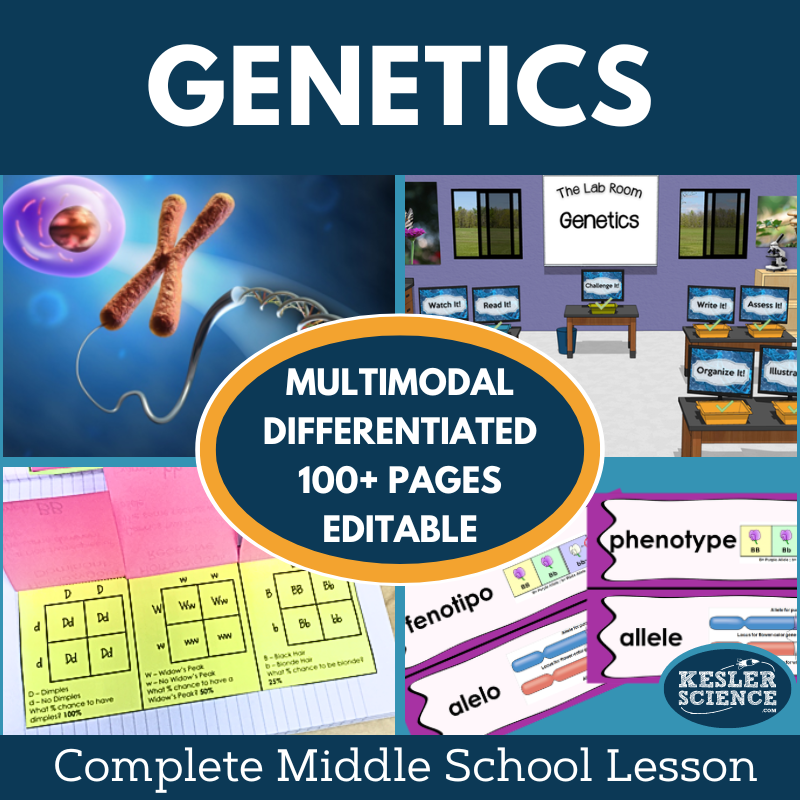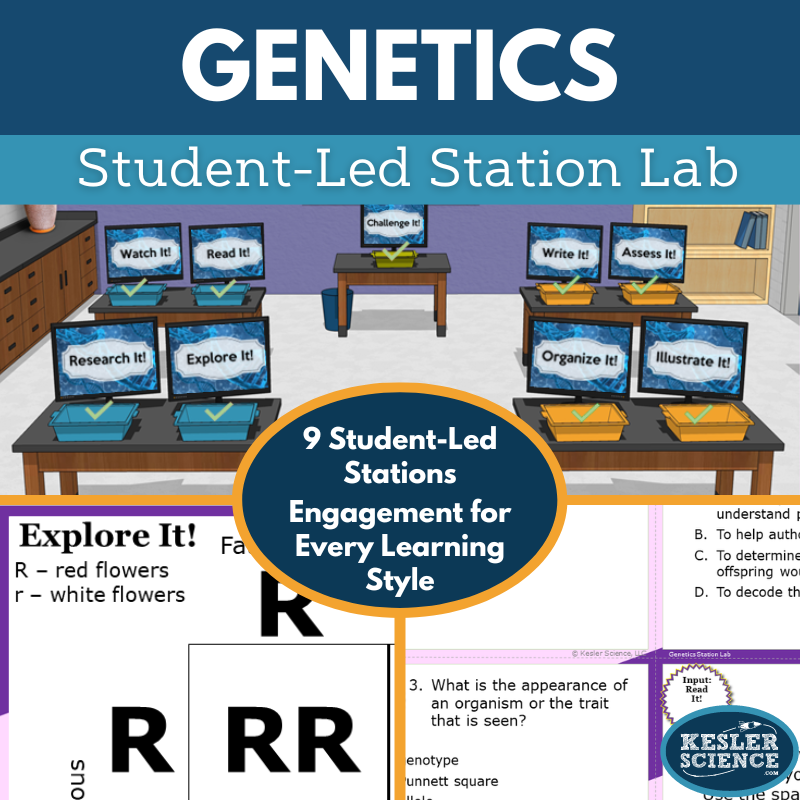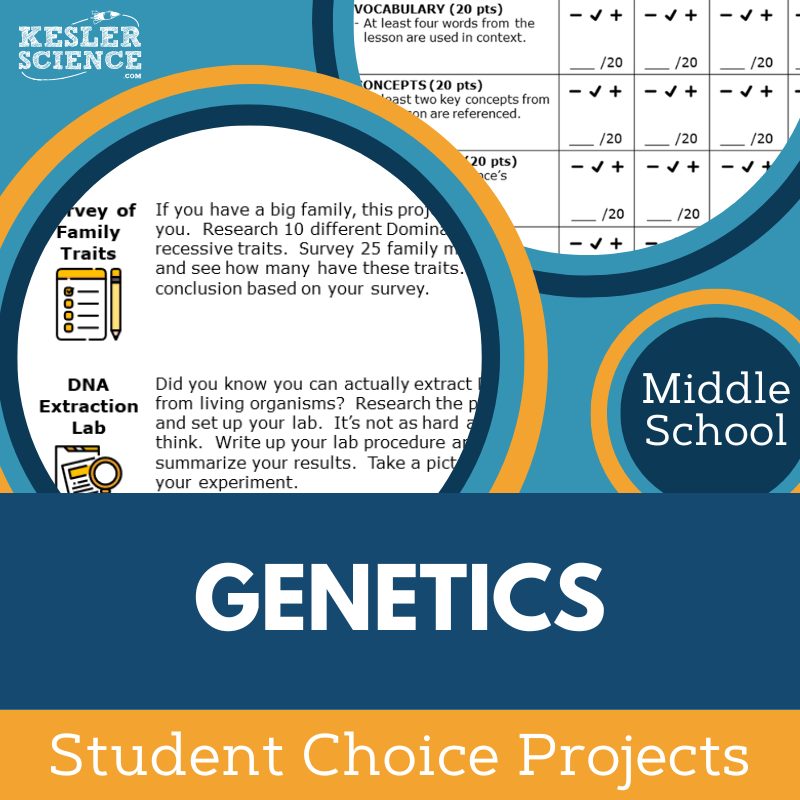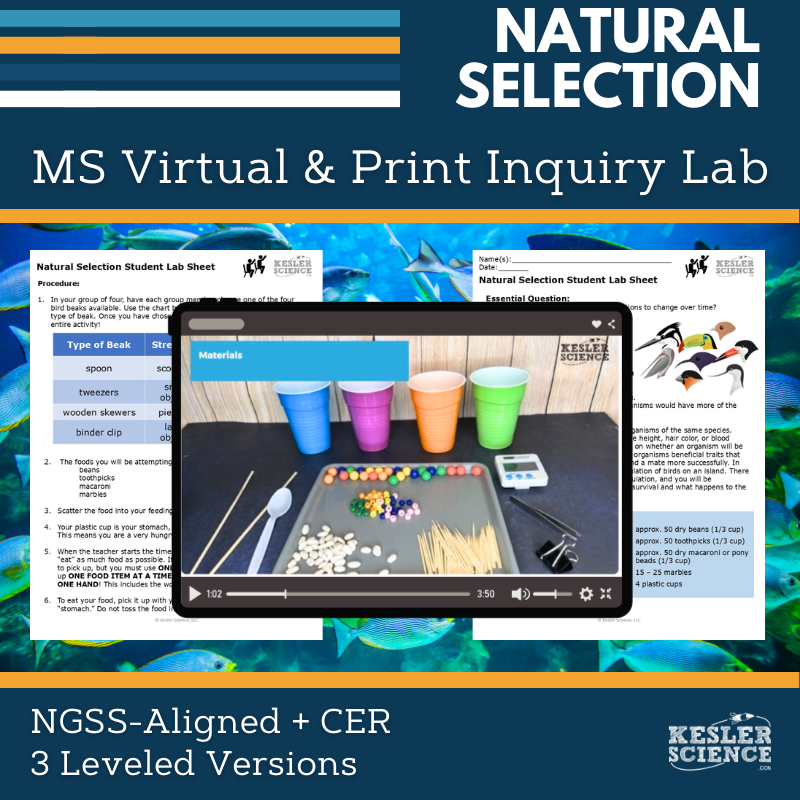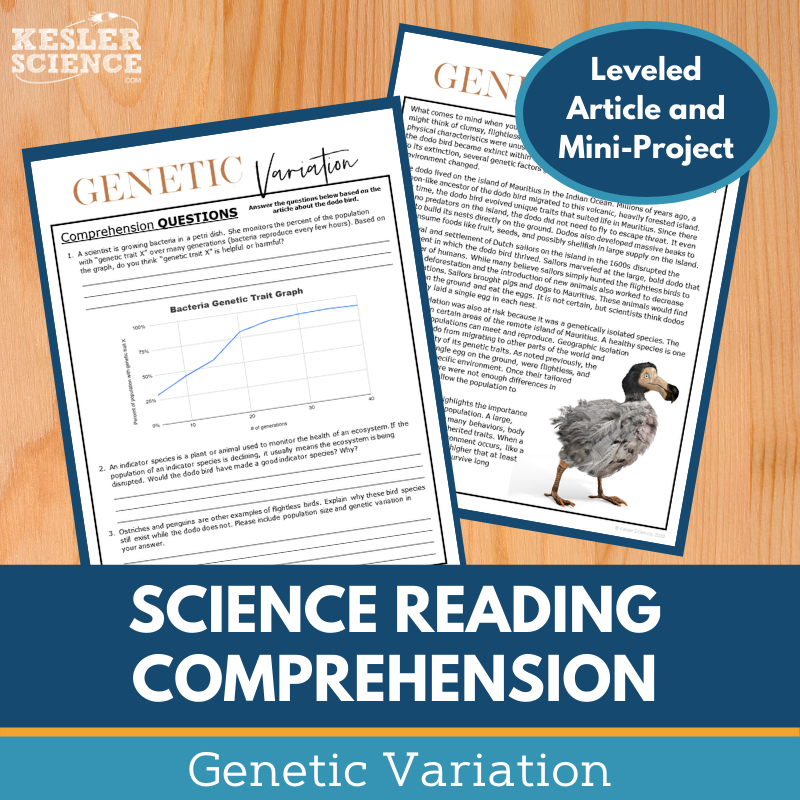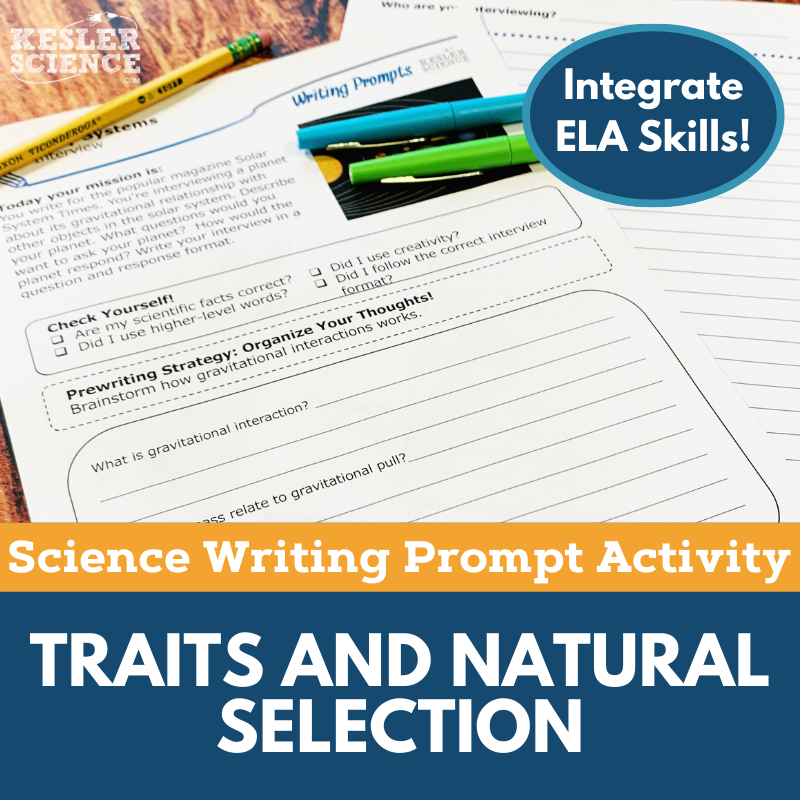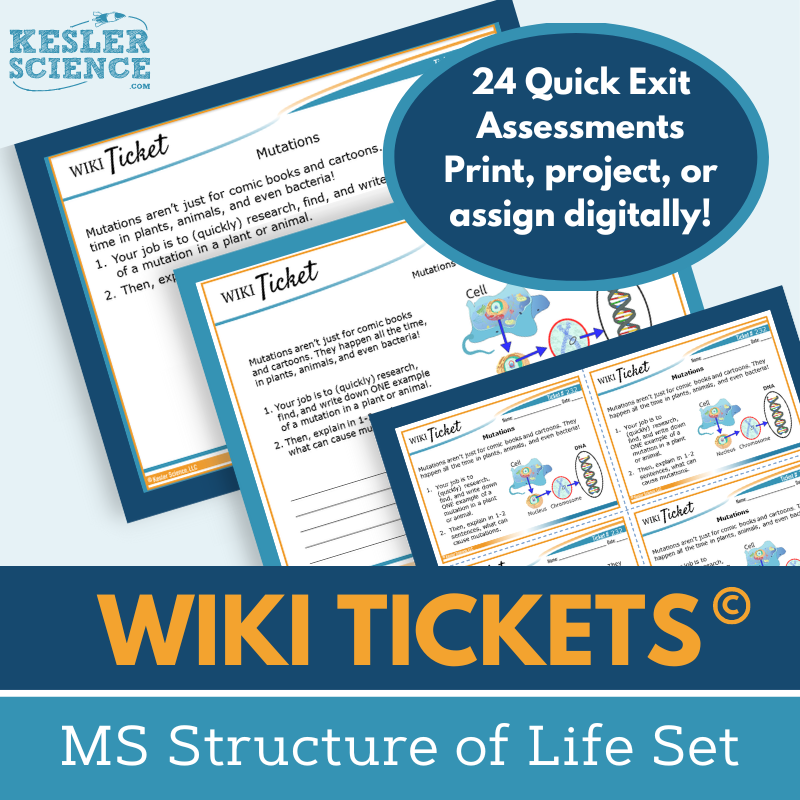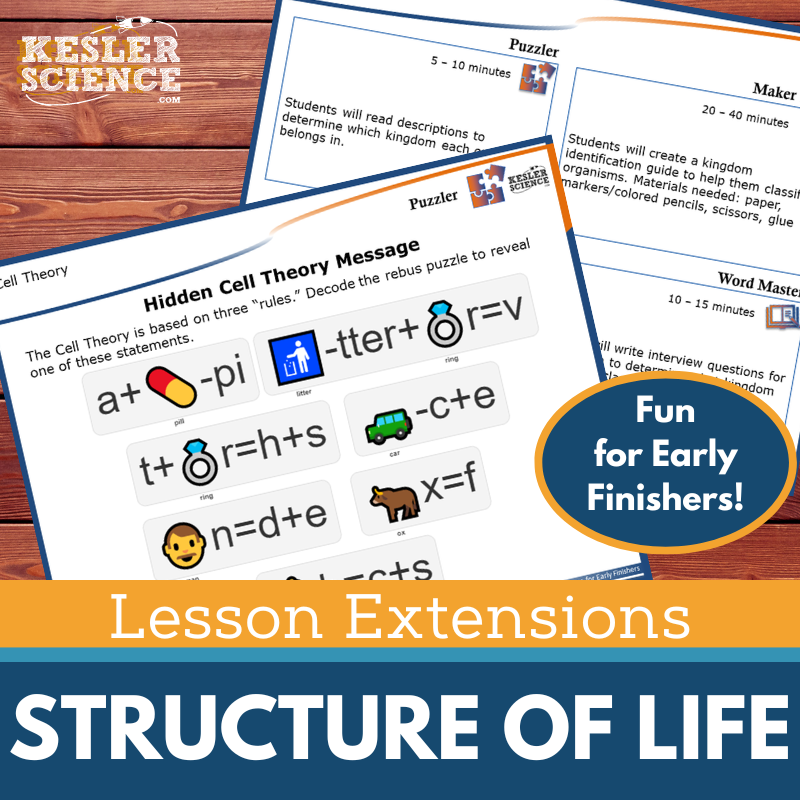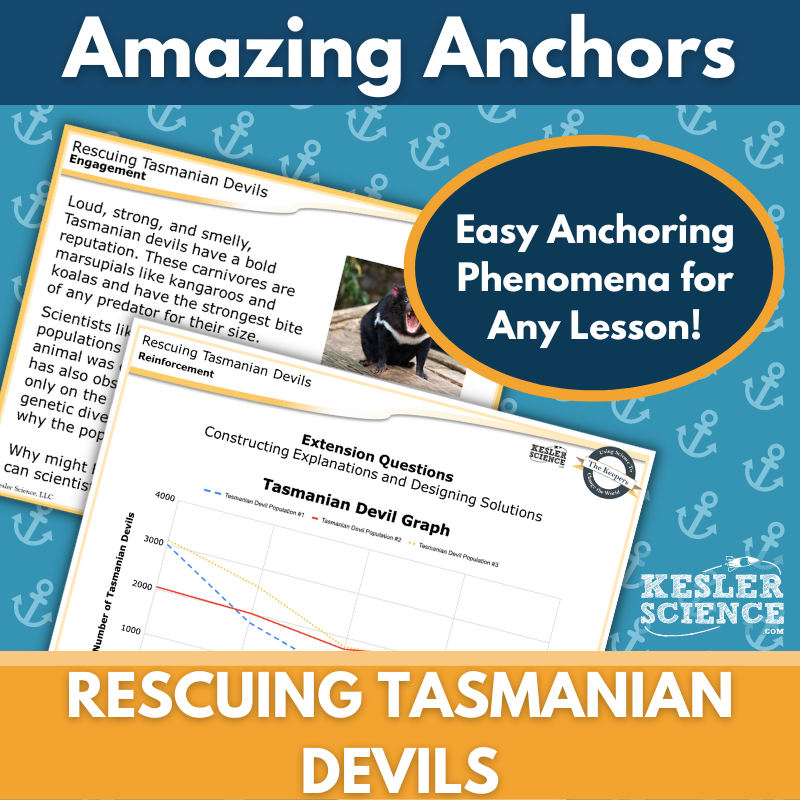Genetic Variation for Survival Activities for Middle School Science
This engaging, student-led genetics lesson for middle school aligns with TEKS and NGSS, guiding students through Punnett squares and essential genetic concepts. The resources below will give students a comprehensive understanding of genetic variation. All of the following materials are also included in the Kesler Science Membership.
The Kesler Science Genetics 5E Lesson is a comprehensive, student-led unit designed for middle school, incorporating presentations, worksheets, choice projects, and assessments. Fully editable and requiring minimal prep, the lesson supports differentiated, multimodal learning with printable and digital formats, as well as Spanish translations for key materials.
TEKS and NGSS aligned, this lesson engages students with essential questions about genetics and Punnett squares. The 5E Model structure includes an engaging teacher-guided discussion and interactive word wall cards. Exploration features a differentiated station lab with nine stations, incorporating hands-on experiments, reading passages, research activities, videos, and creative assessments. Explanation includes editable PowerPoints, interactive notebooks, and structured note-taking templates. Elaboration offers student-choice projects to extend learning, while Evaluation provides STAAR 2.0-aligned assessments and review materials.
This flexible resource is ideal for in-person or virtual learning, ensuring accessibility for diverse learners.
The Kesler Science Genetics 5E Lesson is a comprehensive, student-led unit designed for middle school, incorporating presentations, worksheets, choice projects, and assessments. Fully editable and requiring minimal prep, the lesson supports differentiated, multimodal learning with printable and digital formats, as well as Spanish translations for key materials.
TEKS and NGSS aligned, this lesson engages students with essential questions about genetics and Punnett squares. The 5E Model structure includes an engaging teacher-guided discussion and interactive word wall cards. Exploration features a differentiated station lab with nine stations, incorporating hands-on experiments, reading passages, research activities, videos, and creative assessments. Explanation includes editable PowerPoints, interactive notebooks, and structured note-taking templates. Elaboration offers student-choice projects to extend learning, while Evaluation provides STAAR 2.0-aligned assessments and review materials.
This flexible resource is ideal for in-person or virtual learning, ensuring accessibility for diverse learners.
Engage your students with this student-led genetics station lab, designed to promote independent learning and critical thinking. This structured yet flexible activity allows students to explore and compare genetic characteristics through nine interactive stations, each offering a unique way to encounter and demonstrate understanding of genetics.
Students engage with new concepts through hands-on demonstrations, research tasks, reading passages, and videos. They then showcase their learning by organizing information, illustrating models, writing responses, and completing assessments. A bonus challenge station provides extension activities for early finishers.
This low-prep, high-engagement resource includes all necessary signage, literature, resources, and task cards for independent or small-group work. Available in both physical and digital formats, it supports in-class and virtual learning.
Engage your students with this student-led genetics station lab, designed to promote independent learning and critical thinking. This structured yet flexible activity allows students to explore and compare genetic characteristics through nine interactive stations, each offering a unique way to encounter and demonstrate understanding of genetics.
Students engage with new concepts through hands-on demonstrations, research tasks, reading passages, and videos. They then showcase their learning by organizing information, illustrating models, writing responses, and completing assessments. A bonus challenge station provides extension activities for early finishers.
This low-prep, high-engagement resource includes all necessary signage, literature, resources, and task cards for independent or small-group work. Available in both physical and digital formats, it supports in-class and virtual learning.
The Genetics Student Choice Projects lesson aligns with NGSS standards, allowing middle school students to select a project that fits their preferred output style. A project page outlines six student-led options plus a “design your own” project, all with an editable rubric for teacher, peer, or self-assessment.
These flexible, multimodal projects offer creative ways for students to demonstrate their understanding. Two versions of the project page support differentiation, with modified options for students needing remediation and challenge opportunities for advanced learners. Teachers can adjust the rubric to fit grading needs.
The projects use standard classroom supplies like paper, markers, and scissors, with many options available for digital completion.
The Genetics Student Choice Projects lesson aligns with NGSS standards, allowing middle school students to select a project that fits their preferred output style. A project page outlines six student-led options plus a “design your own” project, all with an editable rubric for teacher, peer, or self-assessment.
These flexible, multimodal projects offer creative ways for students to demonstrate their understanding. Two versions of the project page support differentiation, with modified options for students needing remediation and challenge opportunities for advanced learners. Teachers can adjust the rubric to fit grading needs.
The projects use standard classroom supplies like paper, markers, and scissors, with many options available for digital completion.
The Natural Selection Inquiry Lab aligns with NGSS MS-LS4-4, guiding students to construct explanations based on evidence describing how genetic variations in a population impact survival and reproduction. This lab allows students to investigate how different bird beak shapes affect their ability to gather food, demonstrating natural selection in action.
Students can engage through either a hands-on, print-based experiment or a fully digital, interactive version. The print format provides structured procedures, while the digital version includes a pre-recorded video demonstrating how different tools mimic bird beaks. Both formats include comprehension questions, Claim-Evidence-Reasoning (C.E.R.) prompts, and reflection activities.
The lab is differentiated into three levels: Dependent (moderate guidance with inquiry questions), Modified (structured with sentence stems and multiple-choice options), and Independent (student-led with minimal guidance). Editable PowerPoint and Google Slides formats allow for customization, and teacher resource pages, answer keys, and reflection prompts support instruction. The flexible design ensures accessibility for all learners, whether in-person or virtual.
The Natural Selection Inquiry Lab aligns with NGSS MS-LS4-4, guiding students to construct explanations based on evidence describing how genetic variations in a population impact survival and reproduction. This lab allows students to investigate how different bird beak shapes affect their ability to gather food, demonstrating natural selection in action.
Students can engage through either a hands-on, print-based experiment or a fully digital, interactive version. The print format provides structured procedures, while the digital version includes a pre-recorded video demonstrating how different tools mimic bird beaks. Both formats include comprehension questions, Claim-Evidence-Reasoning (C.E.R.) prompts, and reflection activities.
The lab is differentiated into three levels: Dependent (moderate guidance with inquiry questions), Modified (structured with sentence stems and multiple-choice options), and Independent (student-led with minimal guidance). Editable PowerPoint and Google Slides formats allow for customization, and teacher resource pages, answer keys, and reflection prompts support instruction. The flexible design ensures accessibility for all learners, whether in-person or virtual.
This Genetic Variation Science Reading Comprehension Lesson explores how genetic traits impact survival and reproduction in different environments. Middle school students read a nonfiction article about genetic variation, answer comprehension questions, and research the feasibility of bringing an extinct animal back to life through a slideshow project.
The resource includes two leveled science passages (Lexile 1100-1300), five to seven comprehension questions, a hands-on mini-project, and a Cornell notes template. Designed for grades 6-8, it supports reading comprehension and science literacy with engaging visuals that print easily in grayscale.
Ideal for sub plans, extra credit, ISS, or whole-class instruction, this resource fosters critical thinking, classroom discussions, and textual analysis. It is compatible with Google Classroom, MS Teams, Schoology, and Canvas, allowing students to complete assignments in person or remotely.
This Genetic Variation Science Reading Comprehension Lesson explores how genetic traits impact survival and reproduction in different environments. Middle school students read a nonfiction article about genetic variation, answer comprehension questions, and research the feasibility of bringing an extinct animal back to life through a slideshow project.
The resource includes two leveled science passages (Lexile 1100-1300), five to seven comprehension questions, a hands-on mini-project, and a Cornell notes template. Designed for grades 6-8, it supports reading comprehension and science literacy with engaging visuals that print easily in grayscale.
Ideal for sub plans, extra credit, ISS, or whole-class instruction, this resource fosters critical thinking, classroom discussions, and textual analysis. It is compatible with Google Classroom, MS Teams, Schoology, and Canvas, allowing students to complete assignments in person or remotely.
The Traits and Natural Selection Science Writing Prompt Activity engages middle school students in a creative letter-writing exercise to test their knowledge of life science. Aligned with MS-LS4-4, this student-centered activity helps students construct explanations based on evidence, exploring how genetic variations influence survival and reproduction. Designed for both in-person and virtual learning, it supports science reasoning and writing skills in an engaging format.
This resource includes teacher directions with an answer guide, project ideas, and rubrics. It offers projection and print-friendly handouts, including full-sized and half-sheet versions with prompts, self-checks, and pre-writing strategies. A digital interactive PowerPoint version, compatible with Google Slides, allows for flexible learning. Ideal for cross-curricular activities, pre-tests, student choice projects, extra credit, make-up work, and differentiation, this writing prompt fosters creativity and science literacy while reinforcing key concepts in traits and natural selection.
The Traits and Natural Selection Science Writing Prompt Activity engages middle school students in a creative letter-writing exercise to test their knowledge of life science. Aligned with MS-LS4-4, this student-centered activity helps students construct explanations based on evidence, exploring how genetic variations influence survival and reproduction. Designed for both in-person and virtual learning, it supports science reasoning and writing skills in an engaging format.
This resource includes teacher directions with an answer guide, project ideas, and rubrics. It offers projection and print-friendly handouts, including full-sized and half-sheet versions with prompts, self-checks, and pre-writing strategies. A digital interactive PowerPoint version, compatible with Google Slides, allows for flexible learning. Ideal for cross-curricular activities, pre-tests, student choice projects, extra credit, make-up work, and differentiation, this writing prompt fosters creativity and science literacy while reinforcing key concepts in traits and natural selection.
The WIKI Tickets© Structure of Life Set offers 24 formative assessments designed for 6th-8th grade science, providing flexible and engaging ways to check student understanding. Each topic is available in five formats: a full-screen projection version, three printable handout sizes, and an interactive digital version compatible with PowerPoint and Google Slides.
Aligned with NGSS and TEKS standards, these assessments cover essential life science topics such as cell function, environmental genetic factors, heredity, reproduction, levels of cellular organization, and genetic mutations. A bonus table of contents file is included to show standard alignment. These WIKI Tickets© can be used for in-person or virtual learning, making them versatile for any classroom setting. Students can respond on paper, digitally, or in a remote 1:1 environment. Use them as exit tickets, bellringers, or quick checks to assess student progress effectively.
The WIKI Tickets© Structure of Life Set offers 24 formative assessments designed for 6th-8th grade science, providing flexible and engaging ways to check student understanding. Each topic is available in five formats: a full-screen projection version, three printable handout sizes, and an interactive digital version compatible with PowerPoint and Google Slides.
Aligned with NGSS and TEKS standards, these assessments cover essential life science topics such as cell function, environmental genetic factors, heredity, reproduction, levels of cellular organization, and genetic mutations. A bonus table of contents file is included to show standard alignment. These WIKI Tickets© can be used for in-person or virtual learning, making them versatile for any classroom setting. Students can respond on paper, digitally, or in a remote 1:1 environment. Use them as exit tickets, bellringers, or quick checks to assess student progress effectively.
Lesson Extensions provide engaging, student-choice activities designed to challenge early finishers and deepen their understanding of life science concepts. These activities help reinforce critical thinking, creativity, and problem-solving while keeping students engaged with rigorous yet enjoyable learning opportunities. They are ideal for lesson wrap-ups, independent challenges, and filling downtime during testing.
Each extension includes four interactive components: Puzzler for problem-solving, Maker Space for hands-on STEAM activities, Tech Connection for digital demonstrations, and Word Master for creative writing. With teacher directions, answer keys, and both print and projection versions, these extensions support flexible learning and enrichment.
Covering topics such as artificial selection, body systems, cell functions, genetic variations, heredity, and natural selection, Lesson Extensions align with NGSS and TEKS science standards, ensuring meaningful connections to curriculum goals.
Lesson Extensions provide engaging, student-choice activities designed to challenge early finishers and deepen their understanding of life science concepts. These activities help reinforce critical thinking, creativity, and problem-solving while keeping students engaged with rigorous yet enjoyable learning opportunities. They are ideal for lesson wrap-ups, independent challenges, and filling downtime during testing.
Each extension includes four interactive components: Puzzler for problem-solving, Maker Space for hands-on STEAM activities, Tech Connection for digital demonstrations, and Word Master for creative writing. With teacher directions, answer keys, and both print and projection versions, these extensions support flexible learning and enrichment.
Covering topics such as artificial selection, body systems, cell functions, genetic variations, heredity, and natural selection, Lesson Extensions align with NGSS and TEKS science standards, ensuring meaningful connections to curriculum goals.
This Amazing Anchors Phenomenon Lesson engages students in learning about traits and genetic diversity through a real-world example featuring Tasmanian devils. It includes an introductory reading with comprehension and extension questions to prepare students for further exploration, followed by an explanatory reading that breaks down the science behind traits and genetic diversity with reinforcement questions to deepen understanding.
Aligned with NGSS standard MS LS4-4, this no-prep resource includes teacher directions, answer keys, projection slides, and both digital and print formats for flexible use. A differentiated version provides sentence starters to support students. Designed to bookend a lesson, these readings serve as engaging supplements for the Engagement and Elaborate segments of a 5E lesson in any in-person or virtual classroom.
This Amazing Anchors Phenomenon Lesson engages students in learning about traits and genetic diversity through a real-world example featuring Tasmanian devils. It includes an introductory reading with comprehension and extension questions to prepare students for further exploration, followed by an explanatory reading that breaks down the science behind traits and genetic diversity with reinforcement questions to deepen understanding.
Aligned with NGSS standard MS LS4-4, this no-prep resource includes teacher directions, answer keys, projection slides, and both digital and print formats for flexible use. A differentiated version provides sentence starters to support students. Designed to bookend a lesson, these readings serve as engaging supplements for the Engagement and Elaborate segments of a 5E lesson in any in-person or virtual classroom.
Year-Round Resources
These year-round activities will increase your students' understanding of many middle school science topics. All of these activities are also included in the Kesler Science Membership.
Visual Data & Graphing
You're not alone if your students struggle with understanding graphs, charts, and tables. It's a skill that takes an enormous amount of practice. This resource will help students build a strong foundation in analyzing data and creating their own data visualizations.
Bell Ringers and Warm-Ups
These middle school science bell ringers are an excellent way to engage your students as soon as they walk into your classroom. This comprehensive FULL YEAR resource includes everything you need to start off each science class with an interesting warm-up activity.
Review Board Games
Each game board has been carefully designed to keep students engaged. There are 10 different action spaces on each board and dozens of question cards. All of the actions are related to science concepts and keep the students motivated throughout the game.
Each game is ready to play. Simply print out the board and the cards and let the students enjoy reviewing nine different units.
Essential Questions and Standards
Below are the essential questions and standards associated with the lessons and activities included in the genetic variation for survival unit. This topic is only one of more than 100 middle school science topics included in the Kesler Science Membership.
-
What is genetics?
-
How are Punnett squares used to describe the genetic relationship between parent to offspring?
-
NGSS - MS-LS4-4 Genetic Variation for Survival
Kesler Science Membership
Imagine never having to search for another middle school science lesson again. The membership gives you access to ALL of the Kesler Science products in one place (Yes, including everything above).
Say goodbye to long hours of lesson prep.

